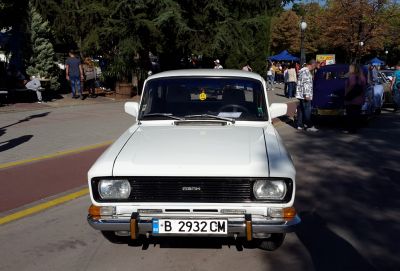 1967 Moskvich 412 Dimensions, Size & Specs
1967 Moskvich 412 Dimensions, Size & SpecsMeasurements of the 1967 Moskvich 412, engineered for optimal performance and comfort
| Dimensions | |
|---|---|
| Length: | 4250 mm167.3 in13.9 ft |
| Width: | 1550 mm61.0 in5.1 ft |
| Height: | 1480 mm58.3 in4.9 ft |
| Weight Specifications | |
| Curb Weight: | 1045 kg2304 lbs |
The Moskvich 412, produced between 1967 and 1969, is a classic Soviet compact sedan that offered a balanced combination of practical size and functionality for its era. With an overall length of 4250 mm (167.3 inches), a width of 1550 mm (61 inches), and a height of 1480 mm (58.3 inches), the Moskvich 412 presents compact exterior dimensions ideal for urban environments and narrow roads common in Eastern Europe during the late 1960s. Weighing in at a curb weight of 1045 kilograms (approximately 2304 pounds), it demonstrates moderate mass contributing to decent maneuverability and fuel efficiency for a sedan of its time. The vehicle's design reflected utility and simplicity, focusing on providing reliable transportation rather than luxury. Its size places it comfortably in the compact sedan segment, making it a useful comparison benchmark for enthusiasts exploring historical car dimensions from the Soviet automotive industry. The Moskvich 412's dimensions highlight the modest, efficient footprints of mid-20th century sedans, contrasting with the larger modern vehicles while maintaining spaciousness for passengers within its compact frame.
Discover the standout features that make the 1967 Moskvich 412 a leader in its class
Have a question? Please check our knowledgebase first.
The Moskvich 412 sedan, produced from 1967 to 1969, measures 4250 mm (167.3 inches) in length, 1550 mm (61.0 inches) in width, and stands 1480 mm (58.3 inches) tall. These dimensions make it a compact and relatively low-profile vehicle of its era, which provides a balanced mix of interior space and exterior manageability.
The curb weight of the Moskvich 412 from 1967-1969 is approximately 1045 kg (2304 pounds). This moderate weight contributes to the car's nimble handling characteristics, aiding in maneuverability and responsiveness. The relatively low mass, paired with the vehicle’s compact size, enabled decent acceleration and fuel efficiency for its time, while also supporting stable driving dynamics on various road conditions.
The Moskvich 412 fits squarely into the compact sedan class. With a length of 4250 mm (167.3 inches) and a width of 1550 mm (61.0 inches), it is smaller than typical mid-sized sedans and aimed at providing economical transportation with ease of parking and urban maneuverability. Its size balanced passenger comfort with the practicality expected from compact vehicles of the late 1960s.
Yes, the Moskvich 412 from 1967 to 1969 will generally fit well inside a standard single-car garage. Most standard garages are about 5400 mm (213 inches) long and 2700 mm (106 inches) wide or larger. Considering the car’s length of 4250 mm (167.3 inches) and width of 1550 mm (61.0 inches), it leaves ample clearance for opening doors and walking space around the vehicle.
Standing at 1480 mm (58.3 inches) tall, the Moskvich 412 offers a relatively low roofline, typical of sedans in its class during the 1960s. This height provides a cozy cabin environment with sufficient headroom for average-height passengers. Aerodynamically, the lower height reduces wind resistance compared to taller vehicles, contributing to improved fuel efficiency and stability at cruise speeds.
Compared to its predecessor, the Moskvich 408, the 412 model maintained a similar compact profile but featured refinements in design and dimensions. The 408 was approximately 4120 mm (162.2 inches) long, making the 412 slightly longer at 4250 mm (167.3 inches). This modest increase improved interior space and comfort while retaining overall maneuverability. The width also remained comparable, ensuring that the 412 was an evolutionary improvement rather than a radical size change.
The Moskvich 412’s dimensions are quite comparable with other compact sedans from the late 1960s, like the Volkswagen Type 3 and Fiat 124. For example, the Volkswagen Type 3 measured around 4290 mm (168.9 inches) in length and 1620 mm (63.8 inches) in width, slightly larger than the Moskvich 412’s 4250 mm length and 1550 mm width. The Fiat 124 was approximately 4050 mm (159.4 inches) long and 1600 mm (63 inches) wide, making it shorter but slightly wider. Thus, the 412 fit well among its peers with a balanced footprint.
While exact interior volume figures for the Moskvich 412 (1967-1969) are not detailed, the sedan comfortably seats four to five passengers. The 4250 mm (167.3 inches) length and 1550 mm (61.0 inches) width allow for a spacious front and rear bench seating layout characteristic of vehicles from that time. Passengers benefited from headroom due to the 1480 mm (58.3 inches) height and a relatively flat floor, making the Moskvich 412 a practical daily sedan.
The 1967 Moskvich 412 showcased several mechanical and design improvements over the Moskvich 408. It featured a new inline-four engine with overhead valves, delivering improved power and efficiency. The body incorporated updated styling with cleaner lines and better aerodynamic qualities. Also, suspension and braking systems were enhanced for safer, more comfortable ride dynamics. These updates made the Moskvich 412 a more modern and competitive car in the compact segment.
The Moskvich 412 was designed to be a practical and affordable vehicle, with reasonable fuel efficiency for its time. It utilized a 1.5-liter overhead valve engine, which helped achieve moderate fuel consumption, typically around 8-10 liters per 100 km (23.5-29 mpg US). Running costs were relatively low due to the simplicity of its mechanical design, availability of parts, and ease of maintenance. This made it a popular choice for daily commuting and family transportation in its production region.
Discover similar sized cars.

| Production: | 1969-1976 |
|---|---|
| Model Year: | 1969 |
| Length: | 4250 mm167.3 in |
| Width: | 1550 mm61.0 in |
| Height: | 1480 mm58.3 in |

| Production: | 1976-1987 |
|---|---|
| Model Year: | 1976 |
| Length: | 4250 mm167.3 in |
| Width: | 1550 mm61.0 in |
| Height: | 1480 mm58.3 in |

| Production: | 1976-1988 |
|---|---|
| Model Year: | 1976 |
| Length: | 4250 mm167.3 in |
| Width: | 1550 mm61.0 in |
| Height: | 1480 mm58.3 in |

| Production: | 1978-1988 |
|---|---|
| Model Year: | 1978 |
| Length: | 4250 mm167.3 in |
| Width: | 1550 mm61.0 in |
| Height: | 1480 mm58.3 in |
